Pavilion of Classic Taiwanese Furniture a Hit at Taipei Furniture Show
2011/06/01 | By Michelle Hsu"ROC Centennial Celebration: Taiwan Furniture Retrospection" series report-1
Furniture masterpieces exhibited the Chinese wisdom of life
In celebration of the centennial anniversary of the Republic of China (ROC), the Taiwan Furniture Manufacturers' Association (TFMA) organized a special pavilion, called "ROC Centennial Celebration: Taiwan Furniture Retrospection," for the 21st Taipei International Furniture Show (TIFS) at the Taipei World Trade Center (TWTC) on March 11-14 this year.
Dozens of the items on display were said to be the most representative furniture products made in Taiwan over the past decades, divided into five categories: classic furniture collected by museums or galleries, winners of furniture design award, customized items for prestigious organizations like the Presidential Office Building and National Taiwan University, winners of national craft awards, and best-selling export furniture.
The items on show were loaned by museums, art galleries, private furniture collectors, designers, and furniture makers. The classic pieces reflected the tastes and lifestyles of Taiwanese consumers, while the best-selling export items represented the golden years of the 1970s-1990s when Taiwan was known as the "Furniture Kingdom."
The customized items made for the Presidential Office Building featured a unique style presenting the richness and sophistication of Chinese culture, and the award winners sported the best craftsmanship and wisdom of Taiwanese furniture masters.
The ROC Centennial Celebration: Taiwan Furniture Retrospection reports introduce the furniture on display in the special pavilion. This article focuses on the museum and gallery furniture, and items from the other four categories will be featured in the next two issues of CENS Furniture.
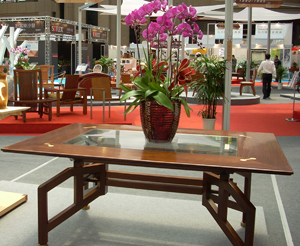
National Taiwan Craft Research and Development Institute
The National Taiwan Craft Research and Development Institute (NTCRDI), an organization dedicated to promoting traditional Taiwanese craftsmanship and arts, was a major contributor of the classic furniture on display in the "ROC Centennial Celebration: Taiwan Furniture Retrospection" pavilion.
The Institute dates back to the early 1950s when its predecessor, the Nantou County Handicraft Research Institute, was established in 1954 as part of the government policy for promoting Taiwanese handicraft. It has since undergone four periods of transformation along with changes in the Taiwanese handicraft industry. The Institute is located in Nantou to take the advantages of abundant raw materials for handicrafts there.
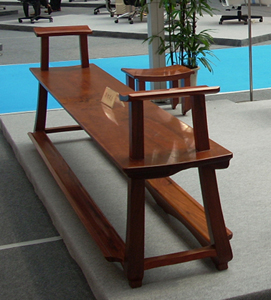
The Institute provides a variety of craftsmanship training courses and collects outstanding masterpieces in a handicraft museum, where furniture is one category of the collection.
One item in the collection, the "Tenon-joined Table," is a typical example of Taiwanese furniture made not with screws or glue but with Chinese wooden tenons. The mortise and tenon joint has been used in Chinese furniture for thousands of years, mainly to join pieces connected at an angle of 90 degrees. This basic method of construction is strong as well as simple, with tenons being inserted into square or rectangular holes cut into the corresponding pieces. The tenons are cut to fit the mortise holes exactly, and usually have shoulders that seat when the joint fully enters the hole.
According to the Institute, this method makes it very easy to assemble the table. The special structure ensures a firm and stable table which, in an extra large size, can be used as a meeting table for a group of seven to eight people.
The table was designed by Lu Yuan-hua, a professor of interior design at Shu-Te University. Lu is also a former chairman of the Chinese Institute of Interior and Architectural Design.
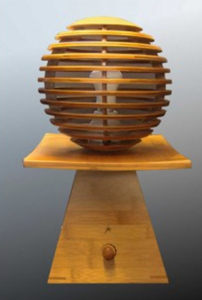
Another of Lu's masterpieces on display in the pavilion was the "Taiwanese Long Bench." With two simple arms on the two sides and stretchers at the bottom, the long bench provides extra functions-people can sit on it, do exercises with it, or lie down on it for a nap. It has no back, but the relatively high arms on the two sides can be used as seatbacks of a sort. Though simple in structure, the long bench provides spacious room for imagination and allows people to place their hands wherever they like. The bench is made of coarse materials and can be placed in open air for an outdoors sunbath.
The "Lying Couch," another piece from the Institutes' collection, is by designer Hong Ta-jen. It's composed of two pieces; each seems a little too wide for an ordinary couche, offering more space for people to lie or sit on.
A little stool designed by Chuang Hsi-chin, also in the Institute's collection, is called "Wind" to emphasize its sleek, flowing lines. Its seat is made of convex wooden stats, a good example of self-ventilating structures used in Chinese furniture. The stool is finer in design and execution than ordinary pieces and is considered ideal for reflecting a carefree lifestyle.
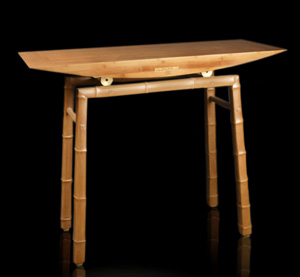
Bamboola Taiwan
Bamboola Taiwan was founded by bamboo lover Liu Wen-huang, who had already been engaged in bamboo research for over two decades before he established the organization in 1980. As a private institution, Bamboola Taiwan has a large collection of bamboo craft items distinguished by Taiwanese craftsmanship, including bamboo furniture, bamboo tea platters, and bamboo stationery and gift items.
Liu notes that bamboo is one of the most representatives of traditional consumer industries in Taiwan. The industry was especially popular in Taiwan and Japan in earlier times, when people used bamboo for daily items such as baskets, plates, toy houses, boats, and ceremonial items for weddings and funerals.
In the eyes of traditional Chinese literati and scholars, bamboo represents the spirit of integrity. Song Dynasty poet Su Dong-po wrote, "People will look pale without meat in a meal, and will appear smug without bamboo in their living place." These lines well illustrate the close interaction between human beings and bamboo.
Bamboo also helps to purify the air, block sound, absorb shock, and beautify the environment. Experiments show that the water in watershed areas with well-developed bamboo forest is more active in vertical than horizontal dispersion; in other words, bamboo helps water penetrate into the soil and keeps it from eroding.
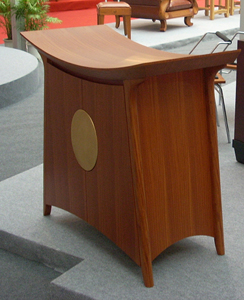
Bamboola Taiwan displayed many pieces of its bamboo furniture in the special pavilion at the show. One of the pieces was bamboo globe light shade, made in 2000, called "Hui Yuan," literally meaning "wisdom and perfection." The globe shade was made of bamboo slats to allow light through and generate a special lighting atmosphere. In Chinese culture, the globe shape is a symbol of perfection.
The "Hexagonal Flower Stand" was another piece reflecting the Chinese preference for round shapes in furniture design. It was made with rounded corners to represent a soft and harmonious feeling; Chinese taste is acutely conscious of smoothness, and has an aversion to hard angles.
"Sunrise" was a bamboo table made of moso bamboo, a high-profile bamboo species that grows in the high mountains. The laminated bamboo table top was supported by bamboo sections serving as legs.
Furniture Bibliotheca HDG
Furniture Bibliotheca HDG is another private institution; it was founded by Lin Tong-yang, a professor at National Taipei University of Technology and an advisor of Taiwan Furniture Manufacturers' Association (TFMA), in 2004. Furniture Bibliotheca operates like a museum, with a collection of around 1,000 pieces of classic furniture from Taiwan and overseas. The collection also contains 90 pieces of furniture prototypes produced during the course of design and development.
Furniture Biblioteca displayed the "Upturned Cabinet," produced in 2004 with a design inspired by the upturned roofs of Chinese temples. A sleek shape and simple curves, however, gave the piece a modern appearance.
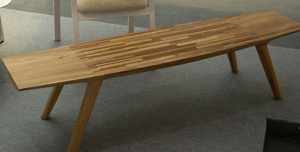
The "Upturned Cabinet" was accompanied by a side table, which also featured upturned sides. In Chinese thinking, an upturned shape implies "rising"-a symbol that augurs good fortune. The table was made of polished hardwood, representing the refined taste of Chinese people.
The "Surfing Bench," by contrast, had a cute and casual look befitting its leisure use. Despite its name the bench, which was made in 2006, had nothing to do with water sports; its name comes from its shape, which resembles that of a surfboard.
The bench was also distinguished by its use of a combination of 10 different kinds of wood (and nothing else), presenting a unique style of Chinese wooden furniture. The glossy natural finish was resistant to moisture and pleasant to the touch.




